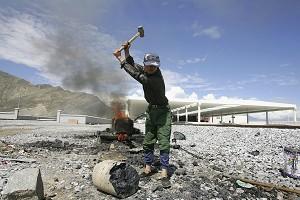The world’s highest railway opened for business on July 1st, spanning nearly 2,000 kilometres from China’s Xining city to Lhasa, in Tibet. About 550km of the track runs over permafrost, thousands of kilometres above sea level. Its highest point sits at an elevation of 5,072 metres—so high that passengers making the first journey donned oxygen masks in the airplane-like cabins.
But the Tibetan railway represents more than an engineering marvel–built with the help of Canadian corporations like Bombardier and Nortel Networks. According to some rights groups, it represents the next step in a cultural genocide being waged by the Beijing government against the Tibetan people.





